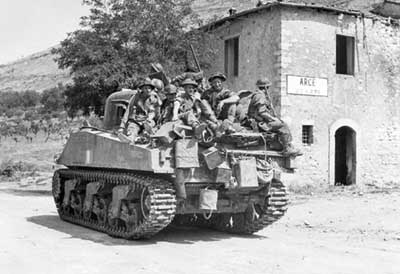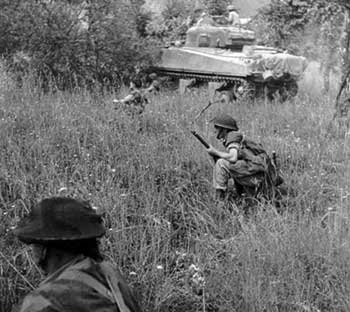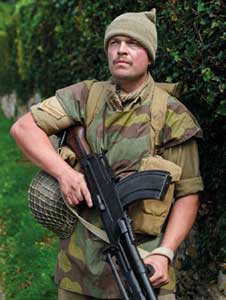|
CAMOUFLAGE SMOCKS USED BY GUARDS BRIGADES IN ITALY - 1944
by Gareth Scanlon
|
The major land campaigns fought by the Foot Guards in the Second World War were in North Africa, North-West Europe, and Italy. Whilst much has been written about the first two campaigns there is comparatively little about the service of the three Guards Brigades in Italy.
201 Guards Brigade (2nd Battalion Scots Guards, 3rd Battalion Coldstream Guards, and 6th Battalion Grenadier Guards) was attached to the 56th Infantry Division and participated in the amphibious landing at Salerno on 3rd September 1943. They fought at Monte Camino during the winter of 1943, sustaining such heavy loses that 201 Brigade was disbanded.
24th Guards Brigade (1st Battalion Scots Guards, 5th Battalion Grenadier Guards, and 3rd Battalion Coldstream Guards), fought at Anzio with the 1st Infantry Division between January and March 1944 where the Brigade suffered 1950 casualties. 24th Brigade later joined the South African 6th Armoured Division.
1st Guards Brigade (3rd Battalion Grenadier Guards, 2nd Battalion Coldstream Guards, [including S Company Scots Guards from 28th March 1944], and 3rd Battalion Welsh Guards (including 2 Company Grenadier Guards from 6th Battalion Grenadier Guards 17th July 1944 to early September 1944) fought with 6th Armoured Division in the Gargliano Salient, Cassino, Liri Valley, Perugia, Arezzo, and the Gothic Line.
 A Sherman tank passes the Arce signpost. 28th May 1944. Imperial War Museum and Neil Powell. www.battlefieldhistorian.com A Sherman tank passes the Arce signpost. 28th May 1944. Imperial War Museum and Neil Powell. www.battlefieldhistorian.com |
Despite being dubbed as the ‘soft underbelly of Europe’ by Winston Churchill, the Italian campaign saw some of the hardest and most ferocious fighting of the war. It was hoped that the Allied invasion of Italy would knock the country out of the war, secure new airfields to further intensify the strategic bombing campaign and enable the Allied armies to enter Austria and thence to the heart of Germany. The campaign was also tie down German divisions and draw in reserves away from North-West Europe and the Eastern Front, the latter meeting demands from Stalin to continue the fight on the second front. The Allies were ill-prepared for Italy’s diverse climate and geography and quickly discovered it did not play to their strengths as a highly mechanised and manoeuvrable modern army. Conversely, the Germans skilfully waged a war of denial and attrition, fighting a slow and tenacious retreat to prepared lines of defence using the mountainous terrain and multiple rivers to inflict maximum delay and destruction. The withdrawal of experienced Allied divisions in preparation for D-Day further exacerbated the challenges faced. This forced the Allied armies in Italy to continually develop, innovate and change to suit the situation and environment.
The author had two great grandfathers who served in Italy with 3rd Battalion Welsh Guards. One of these, 2733859 David Glyndwr Spowart, was a professional soldier who joined the Army in 1934. He spent 552 days in active combat zones: three days in Boulogne in 1940, 97 days in Tunisia, and 452 in Italy. During his time with the 2nd and 3rd Battalions he participated in actions that resulted in 15 battle honours: Boulogne 1940, Fondouk, Djebel el Rhorab, Tunis, Hammam Lif, North Africa 1943, Monte Ornito, Liri Valley, Monte Piccolo, Capture of Perugia, Arezzo, Advance to Florence, Gothic Line, Monte Battaglia and Italy 1944-45.

Grenadier Guardsmen wearing camouflaged smocks. 26th May 1944, following the crossing of the River Melfa heading towards Arce. Note the face veil used as a camouflaged helmet cover by the Guardsman in the left foreground. Neil Powell. www.battlefieldhistorian.com
|
During his research, the author stumbled across a high-resolution photograph, one that he had seen many times before, albeit poorly reproduced. This image enabled him to positively identify his great grandfather Glyn in full battle order with his section. Apart from his obvious surprise and delight at finding this photo, the author became curious about the non-standard clothing that these Guardsmen were wearing. We will all recognise the familiar image of the Second World War Tommy neatly turned out in brown battledress and pack; however, in this photograph the men are wearing khaki US Army Enlisted Man’s shirts, denim battledress trousers, helmets covered in Indian pattern nets, and most a peculiar enemy pattern, M1929 Italian Telo Mimetico camouflage smocks. A blend of uniform from four countries.
These smocks spiked the author’s interest and his quest to learn more about them culminated in his book Camouflaged Fist: Camouflage Smocks used by the Infantry Brigades of the 6th Armoured Division in Italy 1944, published by Helion & Company.
Despite the traditionally strict standards of uniform and dress etiquette in the Foot Guards, this innovation also included loose and sleeveless one-size-fits-all smocks made from captured enemy pattern Italian M1929 Telo Mimetico camouflaged material.

Terence Cuneo’s famous painting depicting Company Sergeant Major T Brown of S Company, Scots Guards rallying the Guardsmen against the 1st German Parachute Regiment holding the summit of Monte Piccolo. Note the Guardsmen wearing smocks to the left foreground. During this action on 28th May 1944 CSM Brown won the Distinguished Conduct Medal
|
In investigating the subject, the author was also extremely lucky to acquire an original smock, one of only a handful of known British examples to survive the war.
The use of camouflage clothing by the British Army during the Second World War was predominantly confined to that issued to the Special Forces. This included the Airborne Smock, Denison, Camouflage (often shortened simply to Denison Smock) used by Airborne and Commando units or to those operating in particular environments, for example in snow. This was later augmented by a more widespread issue of the Smock, Windproof, Camouflage to regular infantry units from 1943 onwards. For most infantrymen, personal concealment and camouflage equipment was limited to the use of a variety of helmet nets, blanco (a compound mixed with water used to colour webbing), early war camouflage capes, blackening of skin and the personal net (face veil).
Following the First World War, the Italian Army was the first to adopt a mass-produced printed design in 1929 with the M1929 Telo Mimetico pattern. Such was the effectiveness of this, in modernised form, that it continued in use as the Italian Army’s principal camouflage pattern into the 1990s.
After the Italian surrender in September 1943, large quantities of the pattern were seized by the Germans and repurposed to make a variety of bespoke garments including caps, tunics, trousers, and fur lined winter coats amongst other items. These feature in well-known photographs taken of the 1st Leibstandarte and 12th Hitlerjugend Waffen-SS Panzer Divisions during the Normandy Campaign in France in 1944.
Stocks of this pattern was also seized by the Allies, most notably in Naples in early 1944. The camouflage smocks used by the Guards in Italy were made systematically by repurposing these captured Italian Telo Tenda in a Royal Army Ordnance Corps factory in theatre.
Italy’s geographical features and location shape its extremely diverse climate. In terms of landscape, the south is quintessentially Mediterranean with dusty rocky hills, sand, sparse vegetation, and cacti. In stark contrast, both Umbria and Tuscany feature green rolling hills, lush valleys, olive groves, vineyards, and cypress lined roads. In further contrast, the Po Valley is very flat with grass hills, dominated by the Alps to the north.
During the winter months, the higher altitudes are cold, wet, and often snowy whereas coastal regions and lowland valleys have mild winters and dry hot summers. Daily temperatures can vary by twenty degrees Celsius across the country over any given day.
Given the frequent short distance changes in environment and landscape encountered, and despite highly regulated unit dress orders, there are numerous photographs illustrating a wide use of both woollen and denim battledress with khaki drill items worn together. Khaki drill, whilst excellent camouflage in North Africa and Southern Italy, were not suitable for the green and lushly grassed landscape of Umbria and Tuscany in the height of summer. Both wool and denim battledress was also often too warm for the climate.
The innovative camouflaged smock, made from the Italian camouflaged material, presented a perfect tactical solution to the changing environments and to the hot climates of central Italy. It was light to wear over a shirt or battledress blouse, easily carried, and enabled the user to blend in with the surroundings more effectively. A perfect example of adapting to the demands of this most arduous theatre.
Personal accounts, documentation and photographs all suggest a timeline of use of the camouflaged smocks from May to December 1944. There is documented evidence of their use by all the battalions of 1st Guards Brigade and by the 1st Battalion Scots Guards and 3rd Battalion Coldstream Guards of 24th Guards Brigade.
The earliest official reference to the garment appears in an Admin Instruction dated 11th May 1944 contained within an appendix of the 3rd Grenadier Guards War Diary at Cassino. However, there is no indication that these were worn at Cassino, since there would be limited need for green camouflage smocks given the subterranean troglodyte existence endured by the troops, with patrolling by night only and the dusty beige urban environment during daytime.
The smocks were used during the breakout into the Liri Valley and at the battles for Monte Piccolo, Orio, and Grande at Arce, and issued at 110 garments per rifle company. They are also recorded in the work of the artist Terence Cuneo, depicting Company Sergeant Major T Brown of ‘S’ Coy, Scots Guards rallying the Guardsmen against the 1st German Parachute Regiment holding the summit of Monte Piccolo. They continue to be used through Umbria and Tuscany where they are famously photographed being worn during the battle for Arezzo.
Whilst not a Guardsman, Alex Bowlby of 2nd Battalion Rifle Brigade, provides a personal view on the garment:
… everybody was issued with green camouflaged smocks. Our pale Khaki Drill, excellent camouflage in the Desert, now stuck out like a range target. German snipers had picked off so many men … that G.H.Q. ponderous ‘Think Machine’ had belatedly decided on a variation of the German camouflage suit, something the Germans have been wearing for years. The smock certainly gave us a sense of protection and in a curious way mine made me feel I had turned professional.1

One of the three known original smocks to survive the war. Gareth Scanlon
|
The wearing of enemy pattern camouflage does not come without risks. Quilter’s title No Dishonourable Name provides an eyewitness account from a Guardsman of 3rd Battalion Coldstream Guards during their fighting with 16th SS Panzergrenadier Division at Gardaletta in October 1944:
… then I realised that only one (of two men) was a German, the man with the gun was a Guardsman from the next platoon, wearing a camouflage smock indistinguishable from the German pattern; and the other, a hulking blonde caricature of a brutal SS man, was his prisoner. I nearly collapsed with relief”.2
From late 1944 the Allies increasingly faced large numbers of troops from the pro-German Italian National Republican Army of the Repubblica Sociale Italiana (RSI), who themselves wore Telo Mimetico pattern camouflage clothing. The final mention of their use is whilst 1st Guards Brigade are occupying Monte Penzola on the Gothic Line in Winter 1944. Following the issue of winter clothing the use of smocks is then discontinued. This is likely due to a combination of this new, and further change, in the environment being encountered and potential friendly fire incidents.

Modern depiction of 3rd Battalion Welsh Guards at Arezzo, July 1944. Modelled by Tom Sellen. Gareth Scanlon
|
The author hopes that his book and this article will highlight the events and achievements of soldiers who served in the Italian Campaign.
Gareth Scanlon is the author of Camouflaged Fist: Camouflage Smocks used by the Infantry Brigades of the 6th Armoured Division in Italy 1944. Published by Helion & Company. https://www.helion.co.uk
References:
1. Bowlby, Alex – The Recollections of Rifleman Bowlby (London: Cassel Military Paperbacks, 1969, Reprint 2002), 91.
2. Quilter, D. C., No Dishonourable Name: Record of the 2nd and 3rd Battalions Coldstream Guards in the Second World War (Manchester: EP Publishing Ltd, 1972), 238, courtesy of Adam Robson.
|
|

 A Sherman tank passes the Arce signpost. 28th May 1944. Imperial War Museum and Neil Powell. www.battlefieldhistorian.com
A Sherman tank passes the Arce signpost. 28th May 1944. Imperial War Museum and Neil Powell. www.battlefieldhistorian.com


